Magnificent Moon - our planet’s nearest neighbour
By Lionel Wijesiri
“How would it be on Earth if the Moon had never existed?”
The question arose last Sunday, Medin Full Moon Day late evening,
while I was having an informal conversation with a few of my friends. It
was fitting question since we were seated in the garden right beneath
the full Moon.
|

The moon is the beautiful satellite of mother Earth |
A number of contributions from the group came immediately. Here are
few of them. Neil Armstrong’s life would have been less exciting. Audrey
Hepburn wouldn’t have sat on the stairs with a guitar and played “Moon
River” in the movie Breakfast at Tiffany’s.
And the myth of werewolves wouldn’t have existed - at least not in
the form we know it today.
Buddhists would not have Sasa Jathaka. The Islamic calendar as well
as a few others, are still based on the moon. Christians calculate the
date of Easter by the full moon. Easter is the first Sunday after the
first full moon after the Spring Equinox. The
Chinese date their new year according to the moon. Without the moon’s
cycle these people might end up with a very different way of keeping
track of time.
Imagine - no solar or lunar eclipses - and this would have changed
our early views of the shape of the Earth. During a lunar eclipse the
curved shadow of our planet can be seen moving across the face of the
moon, giving away the round shape of the Earth.
The words “honeymoon” “‘lunatic” will be out of Dictionary.
The Earth would spin much faster without its orbiting moon. That’s
because the moon’s gravity pulls on Earth’s oceans. The moon is largely
responsible for the tides. The pull of the moon, and ebb and flow of the
tides, puts the brakes on Earth’s daily rotation.
Billions of years ago, Earth spun around on its axis much faster. At
one time, the cycle of day and night was less than ten hours long. If
we’d never had a moon, we’d still have a shorter day. If Earth rotated
faster, other effects would come into play. Wind patterns would likely
be stronger and longer lived. Consider the giant planet Jupiter, which
rotates in about ten hours.
Hurricanes on Jupiter can be enormous and last for centuries. Wind
patterns stretch across the entire planet, giving Jupiter the banded
appearance you can see through a telescope.
The beauty
A constant gale force wind on Earth would have affected life and
evolution. Imagine working, talking, or just walking around against the
howling winds.
Imagine trying to navigate a ship at sea. Exploration would have been
greatly affected (much to the pleasure of some native peoples no doubt!)
It is even possible that some life forms might not even exist under such
conditions.
And of course, it would be darker at night. And there are some other
important differences which would affect our lives tremendously.
Throughout history, the moon has inspired man’s wonder and challenged
his profound curiosity. To primitives and ancients - and to poets of all
eras - our satellite was a pale, wandering goddess of the night. Even to
this day, we uphold mythic moon-worship in our “Monday” or “Moon-day,”
designated by the Romans as the sacred feast-day of the moon.
Of all the celestial sights that pass across the sky, none is more
inspiring or universally appealing than our planet’s lone natural
satellite, the Moon. Remember the rush of excitement that you felt when
you first peered at the rugged lunar surface through a telescope or
binoculars? (If you haven’t, you’ll be amazed.) The first view of its
broad plains, coarse mountain ranges, deep valleys, and countless
craters is a memory cherished by stargazers everywhere.
Since the Moon orbits our planet in the same time that it takes to
rotate once on its own axis, one side of the Moon perpetually faces
Earth. Though the face may be the same, its appearance changes
dramatically during its 27.3-day orbital period, as sunlight strikes it
from different angles as seen from our standpoint. Due to the sunlight’s
changing angle, the Moon presents a slightly different perspective every
night as it passes from phase to phase. No other object in the sky holds
that distinction.
The Moon is the ideal target for all amateur astronomers. It is
bright and large enough to show amazing surface detail, regardless of
the type or size of telescopic equipment, and can be viewed just as
successfully from the centre of a city as from the rural countryside.
Our knowledge
The Moon is roughly one-sixth the size of the Earth and believed to
have formed nearly 4.5 billion years ago, not long after Earth. Although
there have been several hypotheses for its origin in the past, the
current most widely accepted explanation is that the Moon formed from
the debris left over after a giant impact between Earth and a Mars-sized
body.
|

American astronaut Neil Armstrong became the first man to
step on the surface of the moon |
It is approximately 238,000 miles distant from the Earth, has no
atmosphere, and is covered with fine grey powder. We’ve walked on the
moon during six Apollo missions, and we’ve sent many more probes there
to map it and study it.
The Moon’s current orbital distance, about 30 times the diameter of
Earth, causes it to appear almost the same size in the sky as the Sun,
allowing it to cover the Sun nearly precisely in total solar eclipses.
This matching of apparent visual size is a coincidence. The Moon’s
linear distance from Earth is currently increasing at a rate of 3.82 cm
per year, but this rate is not constant.
The moon has more controversial mysteries, too. Some think aliens
have or once had bases there. Some think there’s stuff on the moon -
other than the Apollo debris - and there are many enigmatic photos that
seem to show shapes and structures on the lunar surface that do not fit
conventional explanations.
Galileo
The first to bring man materially closer to the moon was Galileo of
Pisa, who in 1610, fashioned a primitive telescope, and trained it upon
the moon’s mountains and valleys. He even estimated the heights of the
peaks from the length of their shadows. Just above a full century before
Galileo’s discoveries, the magnificent mind of Leonardo da Vinci was
turning to the nature of the moon, and to design of a bat-winged machine
for manned flight.
Leonardo’s predictions about flight and his mechanical “bird”
strangely foreshadow across four and half centuries what man and Apollo
space program have finally accomplished. “The great bird,” he wrote,
“will fill the whole world with amazement and will all records with its
fame. And it will bring eternal glory to the nest where it was born.’”
Our nearest neighbour in space has been a major part of our lives.
The next time you gaze at the moon, think of the role it has played, and
how lost we might be without it! |

